DFN: An Emerging Tool for Stochastic Modelling and Geomechanical Design
Abstract
1. Introduction
2. Background Study
2.1. Overview of Discrete Fracture Network in Mining
2.2. Principles of Modelling in DFN
2.2.1. Fracture Orientation
2.2.2. Fracture Intensity
2.2.3. Spatial Distribution
2.2.4. Fracture Size and Length
3. Data Capturing for DFN Modelling
3.1. DFN Data Acquisition with 3D Laser Scanning Technologies
3.2. Photogrammetry Approach of Collecting DFN Data
4. Application of DFN Approach in Predicting Stability Analysis of Jointed Rock
5. General Applications of DFNs
5.1. Stability Analysis in Mining Operations
5.2. Application of DFN in Petroleum Industry
5.3. Application of DFNs in Tunnels and Underground Construction Works
5.4. Application of DFNs for Underground Flow Prediction
5.5. DFN Application in the Classification of Rock Mass
6. Challenges of Using DFNs
7. Summary and Conclusions
Author Contributions
Funding
Conflicts of Interest
References
- Lei, Q.; Latham, J.-P.; Tsang, C.-F. The use of discrete fracture networks for modelling coupled geomechanical and hydrological behaviour of fractured rocks. Comput. Geotech. 2017, 85, 151–176. [Google Scholar] [CrossRef]
- Stephens, M.B.; Follin, S.; Petersson, J.; Isaksson, H.; Juhlin, C.; Simeonov, A. Review of the deterministic modelling of deformation zones and fracture domains at the site proposed for a spent nuclear fuel repository, Sweden, and consequences of structural anisotropy. Tectonophysics 2015, 653, 68–94. [Google Scholar] [CrossRef]
- Le Goc, R.; Darcel, C.; Davy, P. Advanced DFN Models from Multi-Support Data for Underground Facilities. Procedia Eng. 2017, 191, 1015–1022. [Google Scholar] [CrossRef]
- Davy, P.; Darcel, C.; Le Goc, R.; Munier, R.; Selroos, J.; Mas Ivars, D. DFN, why, how and what for, concepts, theories and issues. In Proceedings of the Seattle, Washington, USA, 2nd International Discrete Fracture Network Engineering Conference, Seattle, WA, USA, 20–22 June 2018. [Google Scholar]
- Adepitan, R.O.; Owolabi, A.; Komolafe, K. Prediction of structural response to blast–induced vibration in Kopek Construction Quarry, Ikere–Ekiti, Ekiti State, Nigeria. Int. J. Environ. Stud. 2018, 75, 990–999. [Google Scholar] [CrossRef]
- Esmailzadeh, A.; Kamali, A.; Shahriar, K.; Mikaeil, R. Connectivity and Flowrate Estimation of Discrete Fracture Network Using Artificial Neural Network. J. Soft Comput. Civ. Eng. 2018, 2, 13–26. [Google Scholar] [CrossRef]
- Xu, C.; Dowd, P. A new computer code for discrete fracture network modelling. Comput. Geosci. 2010, 36, 292–301. [Google Scholar] [CrossRef]
- Grenon, M.; Landry, A.; Hadjigeorgiou, J.; Lajoie, P. Discrete fracture network based drift stability at the Éléonore mine. Min. Technol. 2016, 126, 22–33. [Google Scholar] [CrossRef]
- Huang, N.; Liu, R.; Jiang, Y.; Cheng, Y. Development and application of three-dimensional discrete fracture network modeling approach for fluid flow in fractured rock masses. J. Nat. Gas Sci. Eng. 2021, 91, 103957. [Google Scholar] [CrossRef]
- Miyoshi, T.; Elmo, D.; Rogers, S. Influence of data analysis when exploiting DFN model representation in the application of rock mass classification systems. J. Rock Mech. Geotech. Eng. 2018, 10, 1046–1062. [Google Scholar] [CrossRef]
- Jing, L.; Stephannson, O. Fundamentals of Discrete Element Methods for Rock Engineering: Theory and Applications, 1st ed.; Elsevier: Amsterdam, The Netherlands, 2007. [Google Scholar]
- Weir, F.; Fowler, M. An Introduction to Discrete Fracture Network Modelling and its Geotechnical Applications. In Proceedings of the AUSROCK 2014: Third Australasian Ground Control in Mining Conference, Sydney, NSW, Australia, 5–6 November 2014. [Google Scholar]
- Alghalandis, Y.; Elmo, D.; Eberhardt, E. Similarity analysis of discrete fracture networks. arXiv 2017, arXiv:1711.05257. Available online: https://arxiv.org/pdf/1711.05257. (accessed on 24 August 2022).
- Elmo, D.; Liu, Y.; Rogers, S. Principles of discrete fracture network modelling for geotechnical applications. In Proceedings of the 1st Conference on International Discrete Fracture Network Engineering, Vancouver, BC, Canada, 20 June 2018. [Google Scholar]
- Elmo, D.; Eberhardt, E.; Stead, D.; Rogers, S. Discrete Fracture Network Modelling—Importance of Accounting for Data Uncertainty and Variability. In Proceedings of the Seventh International Conference & Exhibition on Mass Mining (MassMin 2016), Sydney, Australia, 17–19 September 2016. [Google Scholar]
- Rogers, S.; Booth, P.W.; Brzovic, A. Integrated Photogrammetry and Discrete Fracture Network Modelling for Improved Rock Mass Characterization and Engineering Design. In Proceedings of the 15th Australasian Tunnelling Conference, Sydney, NSW, Australia, 17–19 September 2014. [Google Scholar]
- Zhang, W.; Lan, Z.; Ma, Z.; Tan, C.; Que, J.; Wang, F.; Cao, C. Determination of statistical discontinuity persistence for a rock mass characterized by non-persistent fractures. Int. J. Rock Mech. Min. Sci. 2019, 126, 104177. [Google Scholar] [CrossRef]
- Mathis, J.I. To DFN or not DFN—A question of circumstances. In Proceedings of the DFNE 2014, Vancouver, BC, Canada, 20–22 October 2014. [Google Scholar]
- Shariff, L.; Elmo, D.; Stead, D. Dfncleaner: A Novel Automated Approach To Improve DFN Integration for Geomechanical Analysis. In Proceedings of the 2nd International Discrete Fracture Network Engineering Conference, Seattle, WA, USA, 19–21 June 2018. [Google Scholar]
- Shevko, N.; Shaislamov, V.; Savelev, O. Application of Hybrid DPDP-DFN Modeling of Fractured Carbonate Reservoirs. In Proceedings of the SPE Russian Petroleum Technology Conference, Moscow, Russia, 22 October 2019. [Google Scholar]
- Brenner, K.; Hennicker, J.; Masson, R.; Samier, P. Hybrid Dimensional Modelling and Discretization of Two Phase Darcy Flow through DFN in Porous Media. In Proceedings of the 15th European Conference on the Mathematics of Oil Recovery, Amsterdam, The Netherlands, 15–17 August 2016. [Google Scholar] [CrossRef]
- Altundas, B.; Chugunov, N.; Corbett, L.; Brown, A.; Smith, V.; Thachaparambil, M.; Eliseeva, E.; Elghanduri, K.; Hartman, T.; Will, B.; et al. A Hybrid DFN with Elastic Properties to Construct a Seismic Forward Model. In Proceedings of the 15th European Conference on the Mathematics of Oil Recovery, Amsterdam, The Netherlands, 15–17 August 2016. [Google Scholar] [CrossRef]
- Hyman, J.D.; Karra, S.; Makedonska, N.; Gable, C.W.; Painter, S.L.; Viswanathan, H.S. dfnWorks: A discrete fracture network framework for modeling subsurface flow and transport. Comput. Geosci. 2015, 84, 10–19. [Google Scholar] [CrossRef]
- Cheong, J.-Y.; Hamm, S.-Y.; Lim, D.-H.; Kim, S.-G. Hydraulic Parameter Generation Technique Using a Discrete Fracture Network with Bedrock Heterogeneity in Korea. Water 2017, 9, 937. [Google Scholar] [CrossRef]
- Dershowitz, W.; La-Pointe, P.; Doe, T. Advances in Discrete Fracture Network Modeling. In Proceedings of the US EPA/NGWA Fractured Rock Conference, Cambridge, MA, USA, 8–9 November 2000. [Google Scholar]
- Alghalandis, Y. Stochastic Modelling of Fractures in Rock Masses. Ph.D. Thesis, The University of Adelaide, Adelaide, Australia, 2014. [Google Scholar]
- Komolafe, K.; Achuenu, I.; Joro, J.D. Effect of Tantalum on Coltan in Cassiterite Using Mathematical Modeling Approach with Respect to Gibbs Energy. Int. J. Sci. Technol. 2021, 9, 1–17. [Google Scholar]
- Elmo, D.; Stead, D.; Rogers, S. Guidelines for the quantitative description of discontinuities for use in discrete fracture network modelling. In Proceedings of the International Society for Rock Mechanics and Rock Engineering, Montreal, QC, Canada, 13 May 2015. [Google Scholar]
- Zhu, W.; Khirevich, S.; Patzek, T.W. HatchFrac: A Fast Open-Source DFN Modeling Software; King Abdullah University of Science and Technology: Thuwal, Saudi Arabia, 2021. [Google Scholar]
- Tuckwell, G.; Lonergan, L.; Jolly, R. The control of stress history and flaw distribution on the evolution of polygonal fracture networks. J. Struct. Geol. 2003, 25, 1241–1250. [Google Scholar] [CrossRef]
- Kemeny, J.; Post, R. Estimating three-dimensional rock discontinuity orientation from digital images of fracture traces. Comput. Geosci. 2003, 29, 65–77. [Google Scholar] [CrossRef]
- Weismüller, C.; Prabhakaran, R.; Passchier, M.; Urai, J.L.; Bertotti, G.; Reicherter, K. Mapping the fracture network in the Lilstock pavement, Bristol Channel, UK: Manual versus automatic. Solid Earth 2020, 11, 1773–1802. [Google Scholar] [CrossRef]
- Song, J.-J.; Lee, C.-I.; Seto, M. Stability analysis of rock blocks around a tunnel using a statistical joint modeling technique. Tunn. Undergr. Space Technol. 2001, 16, 341–351. [Google Scholar] [CrossRef]
- Whitaker, A.E.; Engelder, T. Characterizing stress fields in the upper crust using joint orientation distributions. J. Struct. Geol. 2005, 27, 1778–1787. [Google Scholar] [CrossRef]
- Staub, I.; Fredriksson, A.; Outters, N. Strategy for a Rock Mechanics; Svensk Kärnbränslehantering AB, Swedish Nuclear Fuel and Waste Management Co: Stockholm, Sweden, 2021. [Google Scholar]
- Zhang, L.; Einsten, H. Estimating the intensity of rock discontinuities. Int. J. Rock Mech. Min. Sci. 2000, 37, 819–837. [Google Scholar] [CrossRef]
- Lu, C.; Tien, Y.; Juang, C. Uncertainty of Fracture Intensity Measurement in Discontinuous Rock Masses—A Sampling Window Approach. In Proceedings of the 53rd U.S. Rock Mechanics/Geomechanics Symposium, New York, NY, USA, 20–22 June 2019. [Google Scholar]
- Kasyanov, M. Continuum Model of Medium with Cracks. J. Eng. Mech. Div. 1980, 106, 1039–1051. [Google Scholar] [CrossRef]
- Dershowitz, W.; Lee, G.; Geier, J.; Foxford, T.; La Pointe, P.; Thomas, A. User Documentation. FracMan, Interactive Discrete Data Analysis, Geometric Modeling, and Exploration Simulation, Version 2; Golder Associates Inc: Toronto, BC, Canada, 1998.
- Berkowitz, B.; Adler, P.M. Stereological analysis of fracture network structure in geological formations. J. Geophys. Res. Earth Surf. 1998, 103, 15339–15360. [Google Scholar] [CrossRef]
- Bour, O.; Davy, P. Connectivity of random fault networks following a power law fault length distribution. Water Resour. Res. 1997, 33, 1567–1583. [Google Scholar] [CrossRef]
- Berkowitz, B. Analysis of fracture network connectivity using percolation theory. J. Int. Assoc. Math. Geol. 1995, 27, 467–483. [Google Scholar] [CrossRef]
- Zhu, W.; Khirevich, S.; Patzek, T. Percolation Properties of Stochastic Fracture Networks in 2D and Outcrop Fracture Maps. In Proceedings of the 80th EAGE Conference and Exhibition, Copenhagen, Denmark, 10 June–15 July 2018. [Google Scholar]
- Yue, G.; Wang, G.; Ma, F.; Zhu, X.; Zhang, H.; Zhou, J.; Na, J. Fracture Characteristics and Reservoir Inhomogeneity Prediction of the Gaoyuzhuang Formation in the Xiong’an New Area: Insights From a 3D Discrete Fracture Network Model. Front. Earth Sci. 2022, 10, 849361. [Google Scholar] [CrossRef]
- Starzec, P.; Andersson, J. Probabilistic predictions regarding key blocks using stochastic discrete fracture networks—Example from a rock cavern in south-east Sweden. Bull. Eng. Geol. Environ. 2002, 61, 363–378. [Google Scholar] [CrossRef]
- Li, M.; Han, S.; Zhou, S.; Zhang, Y. An Improved Computing Method for 3D Mechanical Connectivity Rates Based on a Polyhedral Simulation Model of Discrete Fracture Network in Rock Masses. Rock Mech. Rock Eng. 2018, 51, 1789–1800. [Google Scholar] [CrossRef]
- Benedetto, M.F.; Berrone, S.; Scialò, S. A globally conforming method for solving flow in discrete fracture networks using the Virtual Element Method. Finite Elements Anal. Des. 2016, 109, 23–36. [Google Scholar] [CrossRef]
- Ivanova, V.M.; Sousa, R.; Murrihy, B.; Einstein, H.H. Mathematical algorithm development and parametric studies with the GEOFRAC three-dimensional stochastic model of natural rock fracture systems. Comput. Geosci. 2014, 67, 100–109. [Google Scholar] [CrossRef]
- Weiss, L. The Minor Structures of Deformed Rocks: A Photographic Atlas; Springer: Berlin, Germany, 1972. [Google Scholar]
- Zhang, J.; Liu, R.; Yu, L.; Li, S.; Wang, X.; Liu, D. An Equivalent Pipe Network Modeling Approach for Characterizing Fluid Flow through Three-Dimensional Fracture Networks: Verification and Applications. Water 2022, 14, 1582. [Google Scholar] [CrossRef]
- Liu, R.; Jiang, Y.; Li, B.; Wang, X. A fractal model for characterizing fluid flow in fractured rock masses based on randomly distributed rock fracture networks. Comput. Geotech. 2015, 65, 45–55. [Google Scholar] [CrossRef]
- Schnabel, R.; Wahl, R.; Klein, R. Efficient RANSAC for point-cloud shape detection. In Proceedings of the 2007 Computer Graphics Forum, Warsaw, Poland, 17–20 August 2007; pp. 214–226. [Google Scholar] [CrossRef]
- Zhang, L.; Einstein, H.H. Estimating the Mean Trace Length of Rock Discontinuities. Rock Mech. Rock Eng. 1998, 31, 217–235. [Google Scholar] [CrossRef]
- Ovaskainen, N.; Nordbäck, N.; Skyttä, P.; Engström, J. A new subsampling methodology to optimize the characterization of two-dimensional bedrock fracture networks. J. Struct. Geol. 2022, 155, 104528. [Google Scholar] [CrossRef]
- Kolapo, P. Investigating the Effects of Mechanical Properties of Rocks on Specific Energy and Penetration Rate of Borehole Drilling. Geotech. Geol. Eng. 2021, 39, 1715–1726. [Google Scholar] [CrossRef]
- Kolapo, P.; Cawood, F. Factors to be considered in establishing a scanning laboratory for testing the accuracy of terrestrial laser scanning technologies. Int. J. Min. Miner. Eng. 2020, 11, 180–190. [Google Scholar] [CrossRef]
- Cawood, F.; Yu, M.; Kolapo, P.; Qin, C. Development of a Laboratory for Testing the Accuracy of Terrestrial 3D Laser Scanning Technologies. Int. J. Georesources Environ. 2018, 4, 105–114. [Google Scholar] [CrossRef]
- Tannant, D. Review of Photogrammetry-Based Techniques for Characterization and Hazard Assessment of Rock Faces. Int. J. Geohazards Environ. 2015, 9, 76–87. [Google Scholar] [CrossRef]
- Birch, J.S. Using 3DM analyst mine mapping suite for rock face. In Proceedings of the Laser and Photo-Grammetric Methods for Rock Face Characterization Workshop, Minneapolis, MN, USA, 15–20 December 2006. [Google Scholar]
- Haneberg, W.C. Using close range terrestrial digital photogrammetry for 3-D rock slope modeling and discontinuity mapping in the United States. Bull. Eng. Geol. Environ. 2008, 67, 457–469. [Google Scholar] [CrossRef]
- Kemeny, J.; Turner, K.; Norton, B. LIDAR for Rock Mass Characterization: Hardware, Software, Accuracy and Best-Practices; Tonon, F., Kottenstette, J., Eds.; Laser and Photogrammetric Methods for Rock Face Characterization: Golden, CO, USA, 2006. [Google Scholar]
- Sturzenegger, M.; Stead, D. Close-range terrestrial digital photogrammetry and terrestrial laser scanning for discon-tinuity characterization on rock cuts. Eng. Geol. 2009, 106, 163–182. [Google Scholar] [CrossRef]
- Kolapo, P. Towards a Short-Range Laboratory for Testing the Accuracy of Terrestrial 3D Laser Scanning (TLS) Technologies. Master Thesis, University of Witwatersrand, Johannesburg, South Africa, 2019. [Google Scholar]
- Zhang, K.; Wu, W.; Zhu, H.; Zhang, L.; Li, X.; Zhang, H. A modified method of discontinuity trace mapping using three-dimensional point clouds of rock mass surfaces. J. Rock Mech. Geotech. Eng. 2020, 12, 571–586. [Google Scholar] [CrossRef]
- Ge, Y.; Tang, H.; Xia, D.; Wang, L.; Zhao, B.; Teaway, J.W.; Chen, H.; Zhou, T. Automated measurements of discontinuity geometric properties from a 3D-point cloud based on a modified region growing algorithm. Eng. Geol. 2018, 242, 44–54. [Google Scholar] [CrossRef]
- Maerz, N.H.; Youssef, A.; Otoo, J.N.; Kassebaum, T.J.; Duan, Y. A Simple Method for Measuring Discontinuity Orientations from Terrestrial LIDAR Data. Environ. Eng. Geosci. 2013, 19, 185–194. [Google Scholar] [CrossRef]
- Riquelme, A.J.; Abellan, A.; Tomás, R. Discontinuity spacing analysis in rock masses using 3D point clouds. Eng. Geol. 2015, 195, 185–195. [Google Scholar] [CrossRef]
- Deweza, T.; Montaut, D.; Allanic, C.; Rohmer, J. FACETS: A CloudCompare plugin to extract geological planes from un-structured 3D point clouds. In Proceedings of the International Archives of the Photogrammetry, Remote Sensing and Spatial Information Sciences, Prague, Czech Republic, 12–19 July 2016. [Google Scholar]
- Ferrero, A.M.; Forlani, G.; Roncella, R.; Voyat, H.I. Advanced Geostructural Survey Methods Applied to Rock Mass Characterization. Rock Mech. Rock Eng. 2008, 42, 631–665. [Google Scholar] [CrossRef]
- Gomes, R.K.; Oliveira, P.L.; Gonzaga, L.; Tognoli, M.W.; Veronez, M.R.; Souzab, K.D. An algorithm for automatic detection and orientation estimation of planar structures in LiDAR-scanned outcrops. Comput. Geosci. 2016, 90, 170–178. [Google Scholar] [CrossRef]
- Guo, J.; Wu, L.; Zhang, M.; Liu, S.; Sun, X. Towards automatic discontinuity trace extraction from rock mass point cloud without triangulation. Int. J. Rock Mech. Min. Sci. 2018, 112, 226–237. [Google Scholar] [CrossRef]
- Gigli, G.; Casagli, N. Semi-automatic extraction of rock mass structural data from high resolution LIDAR point clouds. Int. J. Rock Mech. Min. Sci. 2011, 48, 187–198. [Google Scholar] [CrossRef]
- Vazaios, I.; Vlachopoulos, N.; Diederichs, M. DFN generation for Mechanical Stability Analysis of Underground Works. In Proceedings of the ITA WTC 2015 Congress and 41st General Assembly, Dubrovnik, Croatia, 22–28 May 2015. [Google Scholar]
- Iglhaut, J.; Cabo, C.; Puliti, S.; Piermattei, L.; O’Connor, J.; Rosette, J. Structure from Motion Photogrammetry in Forestry: A Review. Curr. For. Rep. 2019, 5, 155–168. [Google Scholar] [CrossRef]
- Jaroslaw, W. Research on Surveying Technology Applied for DTM Modelling and Volume Computation in Open pit Mines. Min. Sci. 2015, 22, 75–83. [Google Scholar]
- Bemis, S.P.; Micklethwaite, S.; Turner, D.; James, M.R.; Akciz, S.; Thiele, S.T.; Bangash, H.A. Ground-based and UAV-Based photogrammetry: A multi-scale, high-resolution mapping tool for structural geology and paleoseismology. J. Struct. Geol. 2014, 69, 163–178. [Google Scholar] [CrossRef]
- Patikova, A. Digital Photogrammetry in the practice of Open Pit Mining. The International Archives of the Photogrammetry. Remote Sens. Spat. Inf. Sci. 2004, 34, 1–4. [Google Scholar]
- Rogers, S.; Bewick, R.; Brzovic, A.; Gaudreau, D. Integrating photogrammetry and discrete fracture network modelling for improved conditional simulation of underground wedge stability. In Proceedings of the Deep Mining 2017: Eighth International Conference on Deep and High Stress Mining, Perth, Australia, 3–6 March 2017. [Google Scholar]
- Benton, D.J.; Seymour, J.B.; Boltz, M.S.; Raffaldi, M.J.; Finley, S.A. Photogrammetry in underground mining ground control-Lucky Friday mine case study. In Proceedings of the Deep Mining 2017: Eighth International Conference on Deep and High Stress Mining, Perth, Australia, 3–6 March 2017. [Google Scholar]
- Li, X.; Liu, J.; Gong, W.; Xu, Y.; Bowa, V.M. A discrete fracture network based modeling scheme for analyzing the stability of highly fractured rock slope. Comput. Geotech. 2021, 141, 104558. [Google Scholar] [CrossRef]
- Le, T.D.; Oh, J. Longwall face stability analysis from a discontinuum-Discrete Fracture Network modelling. Tunn. Undergr. Space Technol. 2022, 124, 104480. [Google Scholar] [CrossRef]
- Singh, J.; Pradhan, S.P.; Singh, M.; Hruaikima, L. Control of structural damage on the rock mass characteristics and its influence on the rock slope stability along National Highway-07, Garhwal Himalaya, India: An ensemble of discrete fracture network (DFN) and distinct element method (DEM). Bull. Eng. Geol. Environ. 2022, 81, 1–23. [Google Scholar] [CrossRef]
- Tóth, E.; Hrabovszki, E.; Schubert, F.; Tóth, T.M. Discrete fracture network (DFN) modelling of a high-level radio-active waste repository host rock and the effects on its hydrogeological behaviour. J. Struct. Geol. 2022, 156, 104556. [Google Scholar] [CrossRef]
- Gao, X.; Zhang, Y.; Hu, J.; Huang, Y.; Liu, Q.; Zhou, J. Site-scale bedrock fracture modeling of a spent fuel reprocessing site based on borehole group in Northwest, China. Eng. Geol. 2022, 304, 106682. [Google Scholar] [CrossRef]
- Zhu, W.; He, X.; Li, Y.; Lei, G.; Santoso, R.; Wang, M. Impacts of fracture properties on the formation and development of stimulated reservoir volume: A global sensitivity analysis. J. Pet. Sci. Eng. 2022, 217, 110852. [Google Scholar] [CrossRef]
- Wu, N.; Liang, Z.; Zhang, Z.; Li, S.; Lang, Y. Development and verification of three-dimensional equivalent discrete fracture network modelling based on the finite element method. Eng. Geol. 2022, 306, 106759. [Google Scholar] [CrossRef]
- Kuppusamy, V. Application of Discrete Fracture Networks (DFN’s) to the design. In Proceedings of the Evolution of Geotech—25 Years of Innovation, Virtual Conference. 20–21 April 2021. [Google Scholar]
- Fesomade, K.I.; Alewi, D.D.; Seidu, S.O.; Saka, S.O.; Osuide, B.I.; Ebidame, G.C.; Ugoh, M.C.; Animasaun, D.O. The Effect of Palm Kernel Shell Ash on the Mechanical and Wear Properties of White Cast Iron. Adv. Technol. Mater. 2020, 45, 20–27. [Google Scholar] [CrossRef]
- Styles, T.; Coggan, J.; Pine, R. Stability Analysis of a Large Fractured Rock Slope Using a DFN-Based. In Proceedings of the Slope Stability 2011: International Symposium on Rock Slope Stability in Open Pit Mining and Civil Engineering, Vancouver, BC, Canada, 18–21 September 2011. [Google Scholar]
- Foster, S.; West, L.; Bottrell, S.; Hildyard, M. A DFN Approach to Evaluating the Hydrogeological Significance of Lithostatic Unloading in Fractured Strata Around Open-Pit Workings. In Proceedings of the 2nd International Discrete Fracture Network Engineering Conference, Seattle, WA, USA, 20–22 June 2018. [Google Scholar]
- Grenon, M.; Hadjigeorgiou, J. Implications of DFN Model Selection in Open Pit Bench Stability Analyses. Boletín Geológicoy Minero 2020, 131, 387–400. [Google Scholar] [CrossRef]
- Kolapo, P.; Oniyide, G.O.; Said, K.O.; Lawal, A.I.; Onifade, M.; Munemo, P. An Overview of Slope Failure in Mining Operations. Mining 2022, 2, 19. [Google Scholar] [CrossRef]
- Bonilla-Sierra, V.; Elmouttie, M.; Donzé, F.-V.; Scholtès, L. Composite wedge failure using photogrammetric measurements and DFN-DEM modelling. J. Rock Mech. Geotech. Eng. 2017, 9, 41–53. [Google Scholar] [CrossRef]
- Rogers, S.F.; Elmo, D.; Webb, G.; Moreno, C. DFN Modelling of Major Structural Instabilities in a Large Open Pit for End of Life Planning Purposes. In Proceedings of the 50th U.S. Rock Mechanics/Geomechanics Symposium, Houston, TX, USA, 5–8 June 2016. [Google Scholar]
- Kong, X.; Xia, Y.; Wu, X.; Wang, Z.; Yang, K.; Yan, M.; Li, C.; Tai, H. Discontinuity Recognition and Information Extraction of High and Steep Cliff Rock Mass Based on Multi-Source Data Fusion. Appl. Sci. 2022, 12, 11258. [Google Scholar] [CrossRef]
- Elmo, D.; Rogers, S.; Stead, D.; Eberhardt, E. Discrete Fracture Network approach to characterise rock mass fragmentation and implications for geomechanical upscaling. Min. Technol. 2014, 123, 149–161. [Google Scholar] [CrossRef]
- Junkin, W.R.; Ben-Awuah, E.; Fava, L. Incorporating DFN Analysis in Rock Engineering Systems Blast Fragmentation Models. In Proceedings of the 53rd U.S. Rock Mechanics/Geomechanics Symposium, New York City, NY, USA, 20–25 June 2019. [Google Scholar]
- Guajardo, C. Application of Discrete Fracture Network to Block Caving Fragmentation: A Hybrid Approach. 2019. Available online: https://www.srk.com/en/publications/application-of-discrete-fracture-network-to-block-caving-fragmentation-a-hybrid-approach (accessed on 19 August 2022).
- Xiao, Y.; Yang, C.; Li, J.; Zhou, K.; Lin, Y.; Sun, G. Estimation of the Mean Trace Length of Discontinuities in an Underground Drift Using Laser Scanning Point Cloud Data. Sustainability 2022, 14, 15650. [Google Scholar] [CrossRef]
- Graaf, J.; Doumis, K.; Rogers, S. Towards the Implementation of Discrete Fracture Network Modelling as a Geotechnical Design Tool—Case Study of Callie Underground Mine. In Proceedings of the Third Australaisia Ground Control in Mining Conference, Sydney, Australia, 5–6 November 2014. [Google Scholar]
- Starzec, P.; Tsang, C.-F. Use of fracture-intersection density for predicting the volume of unstable blocks in underground openings. Int. J. Rock Mech. Min. Sci. 2002, 39, 807–813. [Google Scholar] [CrossRef]
- Elmo, D.; Moffitt, K.; Carvalho, J. Synthetic Rock Mass Modelling: Experience Gained and Lessons Learned. In Proceedings of the 50th U.S. Rock Mechanics/Geomechanics Symposium, Houston, TX, USA, 15–20 June 2016. [Google Scholar]
- Esmaieli, K.; Hadjigeorgiou, J. Application of DFN–DEM modelling in addressing ground control issues at an underground mine. Min. Technol. 2015, 124, 138–149. [Google Scholar] [CrossRef]
- Harthong, B.; Scholtes, L.; Donze´, F.-V. Strength characterization of rock masses, using a coupled DEM–DFN model. Geophys. J. Int. 2021, 191, 467–480. [Google Scholar] [CrossRef]
- Javadi, M.; Sharifzadeh, M. Assessment of Inflow Possibility into Underground Excavations Using DFN and Percolation Concepts. In Proceedings of the 22nd World Mining Congress & Expo, Istanbul, Turkey, 11–16 September 2011. [Google Scholar]
- Li, J.; Wang, Y.; Tan, Z.; Du, W.; Liu, Z. Study on Water Inflow Variation Law of No.1 Shaft Auxiliary Shaft in HighLiGongshan Based on Dual Medium Model. Symmetry 2021, 13, 930. [Google Scholar] [CrossRef]
- Verga, F.; Giglio, G.; Masserano, F.; Ruvo, L. Validation of Near-Wellbore Fracture-Network Models With MDT. SPE Reserv. Evaluation Eng. 2002, 5, 116–125. [Google Scholar] [CrossRef]
- Karatalov, N.; Stefaniak, A.; Vaughan, L. Advanced Modeling of Interwell-Fracturing Interference: An Eagle Ford Shale-Oil Study. In Proceedings of the Abu Dhabi International Petroleum Exhibition & Conference, Abu Dhabi, United Arab Emirates, 7–11 November 2017. [Google Scholar]
- Mahmoodpour, S.; Singh, M.; Obaje, C.; Tangirala, S.K.; Reinecker, J.; Bär, K.; Sass, I. Hydrothermal Numerical Simulation of Injection Operations at United Downs, Cornwall, UK. Geosciences 2022, 12, 296. [Google Scholar] [CrossRef]
- Gentier, S.; Rachez, X.; Ngoc, T.D.T.; Peter-Borie, M.; Souque, C. 3D flow modelling of the medium-term circulation test performed in the deep geothermal site of Soultz-sous-Forêts (France). In Proceedings of the World Geothermal Congress, Bali, Indonesia, 25–30 April 2010; p. 13. [Google Scholar]
- Zhang, F. Effects of Hydraulic Fracture Crossing Natural Fractures Numerical study using hybrid discrete-continuum modelling. In Proceedings of the ISRM Congress 2015 Int’l Symposium on Rock Mechanics, San Francisco, CA, USA, 10–13 October 2015. [Google Scholar]
- Viegas, G.; Urbancic, T.; Baig, A. Rupture Dynamics and Source Scaling Relations of Microseismic Hydraulic Fracture in Shale Reservouir. In Proceedings of the ISRM Congress 2015 Proceedings—Int’l Symposium on Rock Mechanics, San Francisco, CA, USA, 10–13 October 2015. [Google Scholar]
- Wang, H. Discrete fracture networks modeling of shale gas production and revisit rate transient analysis in heterogeneous fractured reservoirs. J. Pet. Sci. Eng. 2018, 169, 796–812. [Google Scholar] [CrossRef]
- Wang, B.; Fidelibus, C. An Open-Source Code for Fluid Flow Simulations in Unconventional Fractured Reservoirs. Geosciences 2021, 11, 106. [Google Scholar] [CrossRef]
- Mahmoodpour, S.; Singh, M.; Turan, A.; Bär, K.; Sass, I. Hydro-Thermal Modeling for Geothermal Energy Extraction from Soultz-sous-Forêts, France. Geosciences 2021, 11, 464. [Google Scholar] [CrossRef]
- Tester, J.W.; Brown, D.W.; Potter, R.M. Hot Dry Rock Geothermal Energy: A New Energy Agenda for the 21st Century; Technical Report, Los Alamos National Lab: Los Alamos, NM, USA, 1989. [Google Scholar]
- Aydin, H.; Akin, S. Discrete Fracture Network Modeling of Alaşehir Geothermal Field. In Proceedings of the 44th Workshop on Geothermal Reservoir Engineering Stanford University, Stanford, CA, USA, 11–13 February 2019. [Google Scholar]
- Jambayev, A.S. Discrete Fracture Network Modeling for a Carbonate Reservoir. Master’s Dissertation, Colorado School of Mines, Denver, CO, USA, 2013. [Google Scholar]
- Kohl, T.; Mégel, T. Predictive modeling of reservoir response to hydraulic stimulations at the European EGS site Soultz-sous-Forêts. Int. J. Rock Mech. Min. Sci. 2007, 44, 1118–1131. [Google Scholar] [CrossRef]
- Cacciari, P.P.; Futai, M.M. Modeling a Shallow Rock Tunnel Using Terrestrial Laser Scanning and Discrete Fracture Networks. Rock Mech. Rock Eng. 2017, 50, 1217–1242. [Google Scholar] [CrossRef]
- Wang, P.; Liu, C.; Qi, Z.; Liu, Z.; Cai, M. A Rough Discrete Fracture Network Model for Geometrical Modeling of Jointed Rock Masses and the Anisotropic Behaviour. Appl. Sci. 2022, 12, 1720. [Google Scholar] [CrossRef]
- Ioannis, V.; Mark, D.; Nicholas, V. Factors affecting realism of DFNs for Mechanical Stability Analysis. In Proceedings of the International Discrete Fracture Network Engineering Conference, Vancouver, BC, Canada, 17–21 September 2014. [Google Scholar]
- Saliu, M.A.; Komolafe, K. Investigating the Effect of Dolomite Exploitation on Groundwater Condition of Ikpeshi, Akoko—Edo, Edo State, Nigeria. J. Earth Sci. Geotech. Eng. 2014, 4, 137–147. [Google Scholar]
- Pham, H.V.; Parashar, R.; Sund, N.; Pohlmann, K. Determination of fracture apertures via calibration of three-dimensional discrete-fracture-network models: Application to Pahute Mesa, Nevada National Security Site, USA. Hydrogeol. J. 2020, 29, 841–857. [Google Scholar] [CrossRef]
- Bordas, J. Modeling Groundwater Flow and Contaminant Transporting Fractured Aquifers. Master’s Thesis, Air Force Institute of Technology, Colombus, OH, USA, 2005. [Google Scholar]
- Parker, B.L.; Cherry, J.A.; Chapman, S.W. Discrete Fracture Network Approach for Studying Contamination in Fractured Rock. Aqua Mundi 2012, 12, 101–116. [Google Scholar] [CrossRef]
- Ogunsola, N.O.; Olaleye, B.M.; Saliu, M.A. Effects of weathering on some physical and mechanical properties of Ewekoro Limestone, South-western Nigeria. Int. J. Eng. Appl. Sci. 2017, 4, 257336. [Google Scholar]
- Ogunsola, N.; Lawal, A.; Saliu, M. Federal University of Technology Akure Variations of physico-mechanical, mineralogical and geochemical properties of marble under the influence of weathering. Min. Miner. Deposits 2019, 13, 95–102. [Google Scholar] [CrossRef]
- Ogunsola, N.O. The effects of weathering on some physical and mechanical properties of selected carbonate rocks in south-western Nigeria. Master’s Dissertation, The Federal University of Technology Akure, Akure, Nigeria, 2016. [Google Scholar]
- Goodman, R. Introduction to Rock Mechanics; Willey: New York, NY, USA, 1989. [Google Scholar]
- Lisjak, A.; Grasselli, G. A review of discrete modeling techniques for fracturing processes in discontinuous rock masses. J. Rock Mech. Geotech. Eng. 2014, 6, 301–314. [Google Scholar] [CrossRef]
- Martin, C.; Kaiser, P.; McCreath, D. Hoek-Brown parameters for predicting the depth of brittle failure around tunnels. Can. Geotech. J. 1999, 1, 136–151. [Google Scholar] [CrossRef]
- Hoek, E.; Diederichs, M. Empirical estimates of rock mass modulus. Int. J. Rock Mech. Min. Sci. 2006, 2, 203–215. [Google Scholar] [CrossRef]
- Hammah, R.E.; Yacoub, T.E.; Corkum, B.; Wibowo, F.; Curran, J.H. Analysis of Blocky Rock Slopes with Finite Element Shear Strength Reduction Analysis; Springer: Vancouver, BC, Canada, 2007; pp. 329–334. [Google Scholar]
- Jarek, J.; Esterhuizen, S.G. Use of the Mining Rock Mass Rating (MRMR) Classification: Industry Experience; U.S. Department of Health and Human Services, Public Health Service, Centers for Disease Control and Prevention, National Institute for Occupational Safety and Health: Pittsburgh, PA, USA, 2007; pp. 73–78. [Google Scholar]
- Sharif, L.K.; Elmo, D.; Stead, D. An Investigation of the Factors Controlling the Mechanical Behaviour of Slender Naturally Fractured Pillars. Rock Mech. Rock Eng. 2020, 53, 5005–5027. [Google Scholar] [CrossRef]
- Shapka-Fels, T.; Elmo, D. Numerical Modelling Challenges in Rock Engineering with Special Consideration of Open Pit to Underground Mine Interaction. Geosciences 2022, 12, 199. [Google Scholar] [CrossRef]
- Mayer, J. Applications of Uncertainty Theory to Rock Mechanics and Geotechnical Mine Design. Master’s Thesis, Simon Fraser University, Burnaby, BC, Canada, 2015. [Google Scholar]
- Elmo, D.; Stead, D. An Integrated Numerical Modelling–Discrete Fracture Network Approach Applied to the Characterisation of Rock Mass Strength of Naturally Fractured Pillars. Rock Mech. Rock Eng. 2009, 43, 3–19. [Google Scholar] [CrossRef]
- Singh, J.; Pradhan, S.P.; Singh, M.; Yuan, B. Modified block shape characterization method for classification of fractured rock: A python-based GUI tool. Comput. Geosci. 2022, 164, 105125. [Google Scholar] [CrossRef]
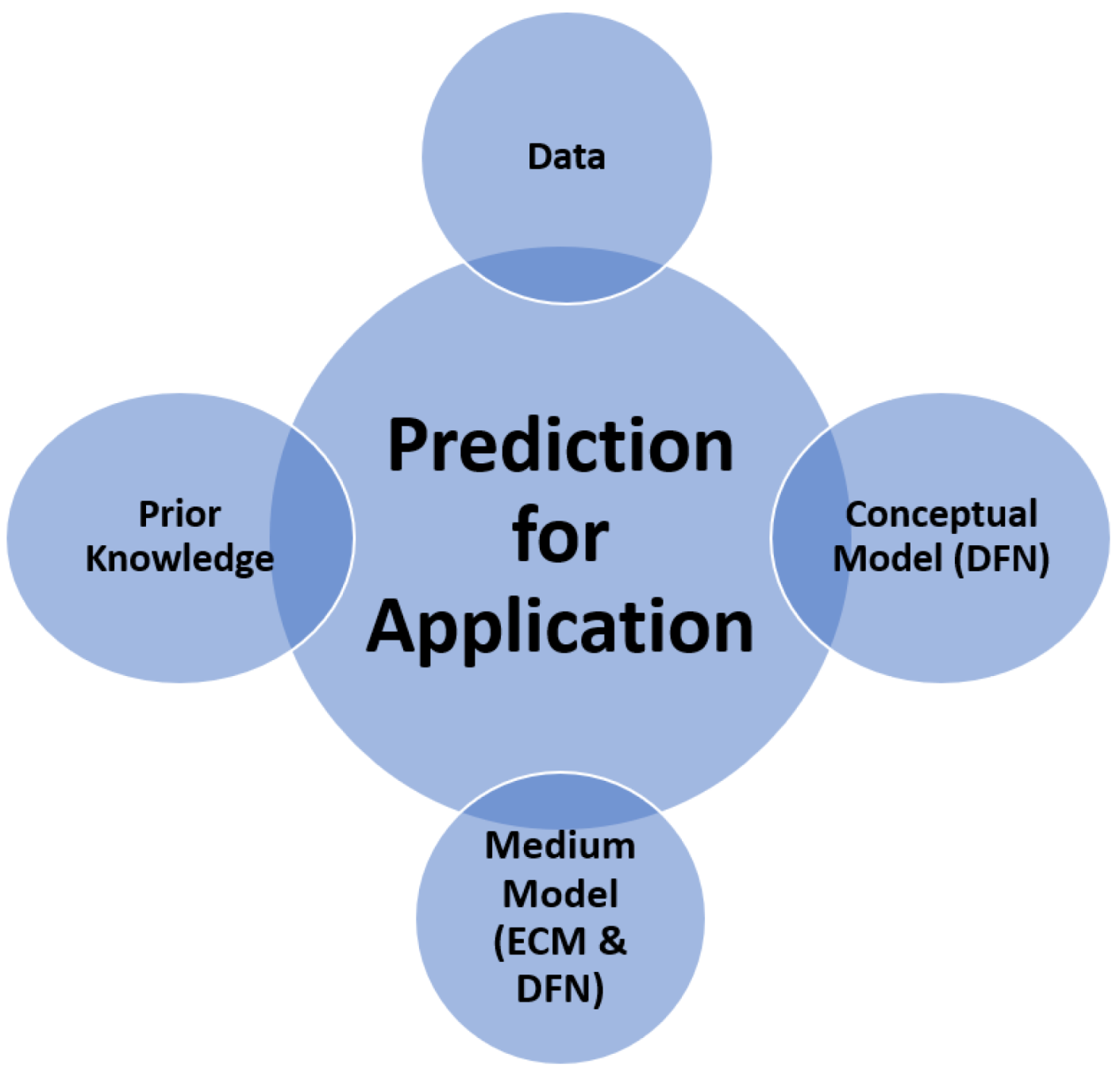
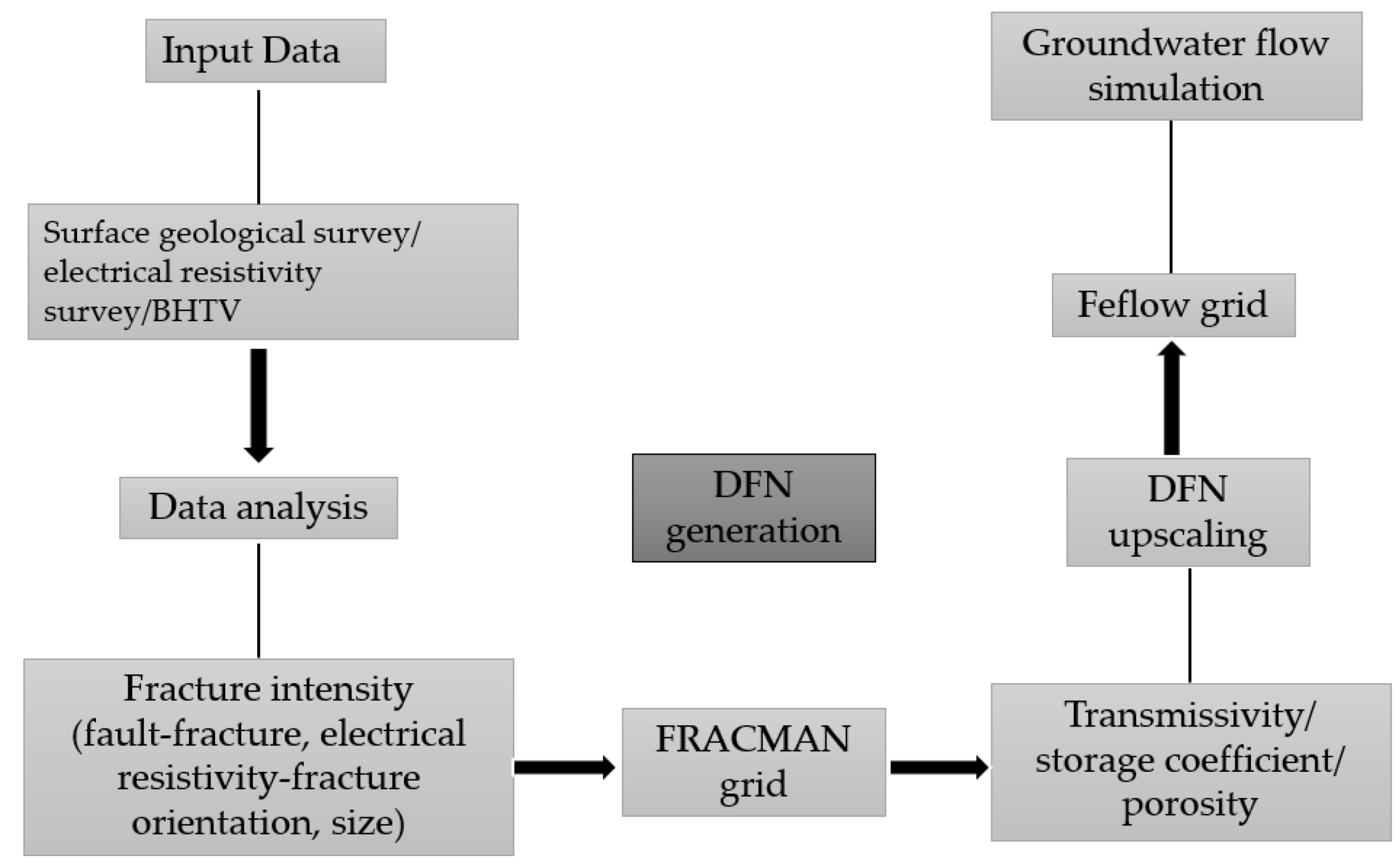
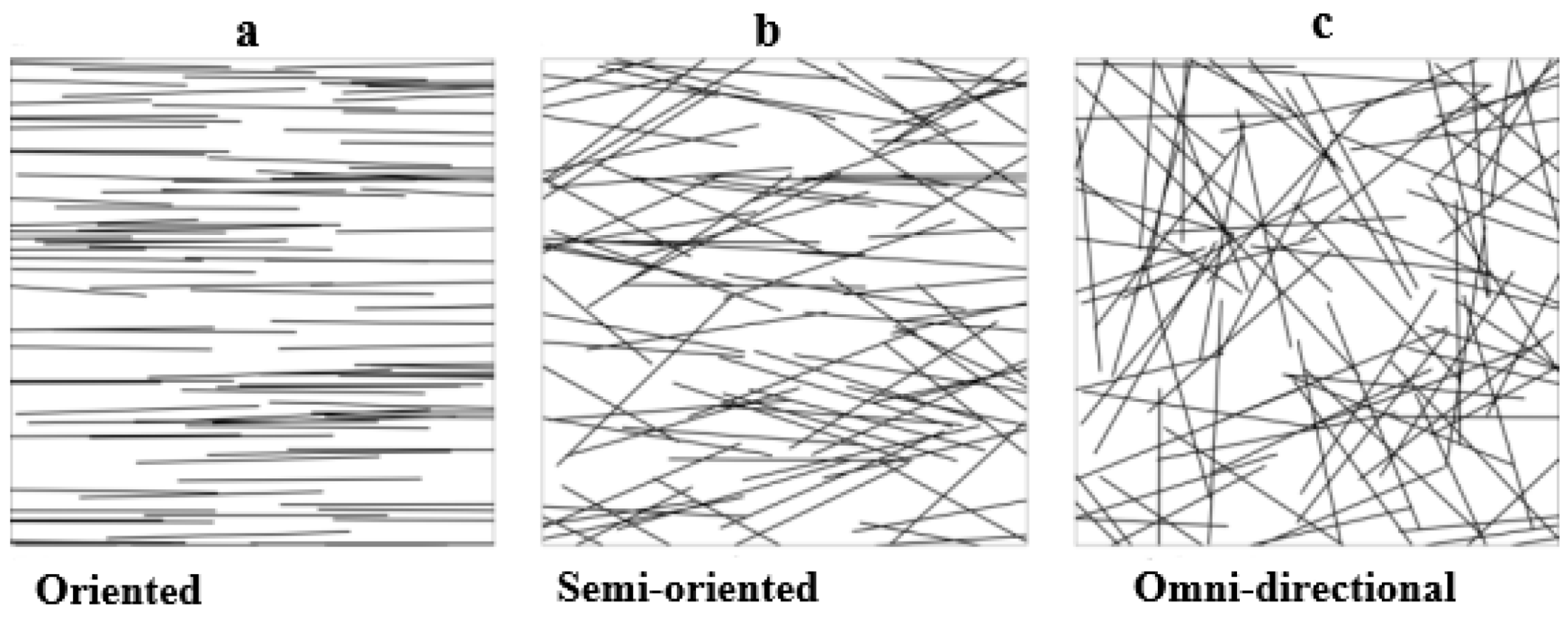


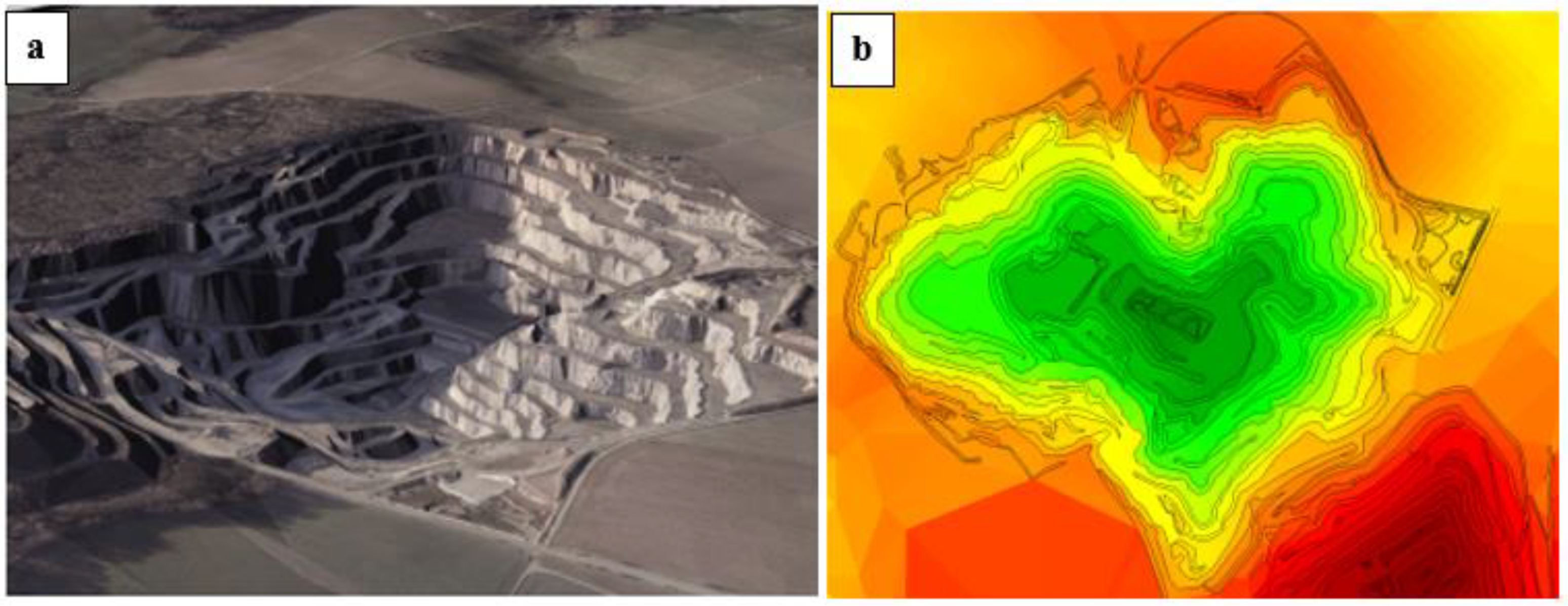

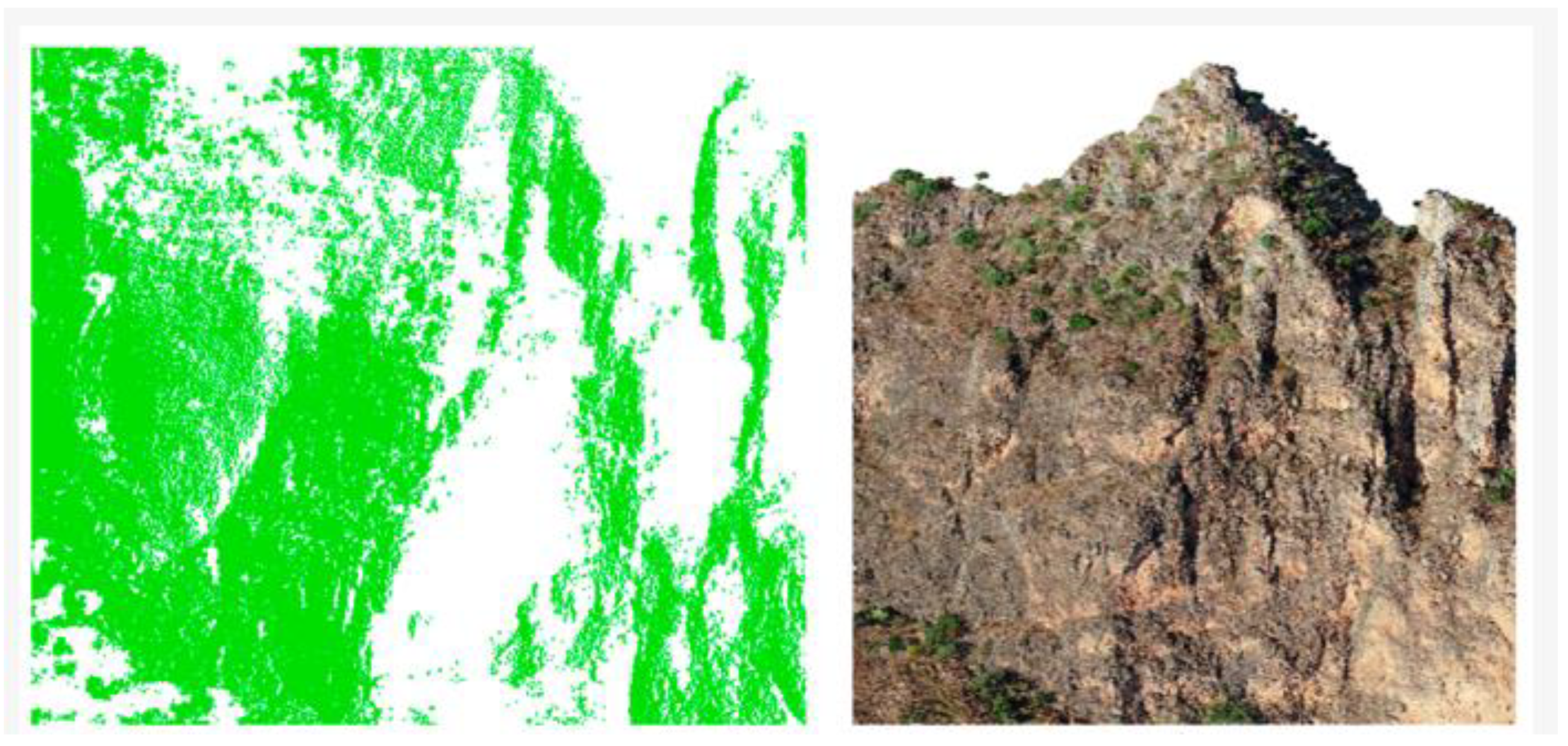
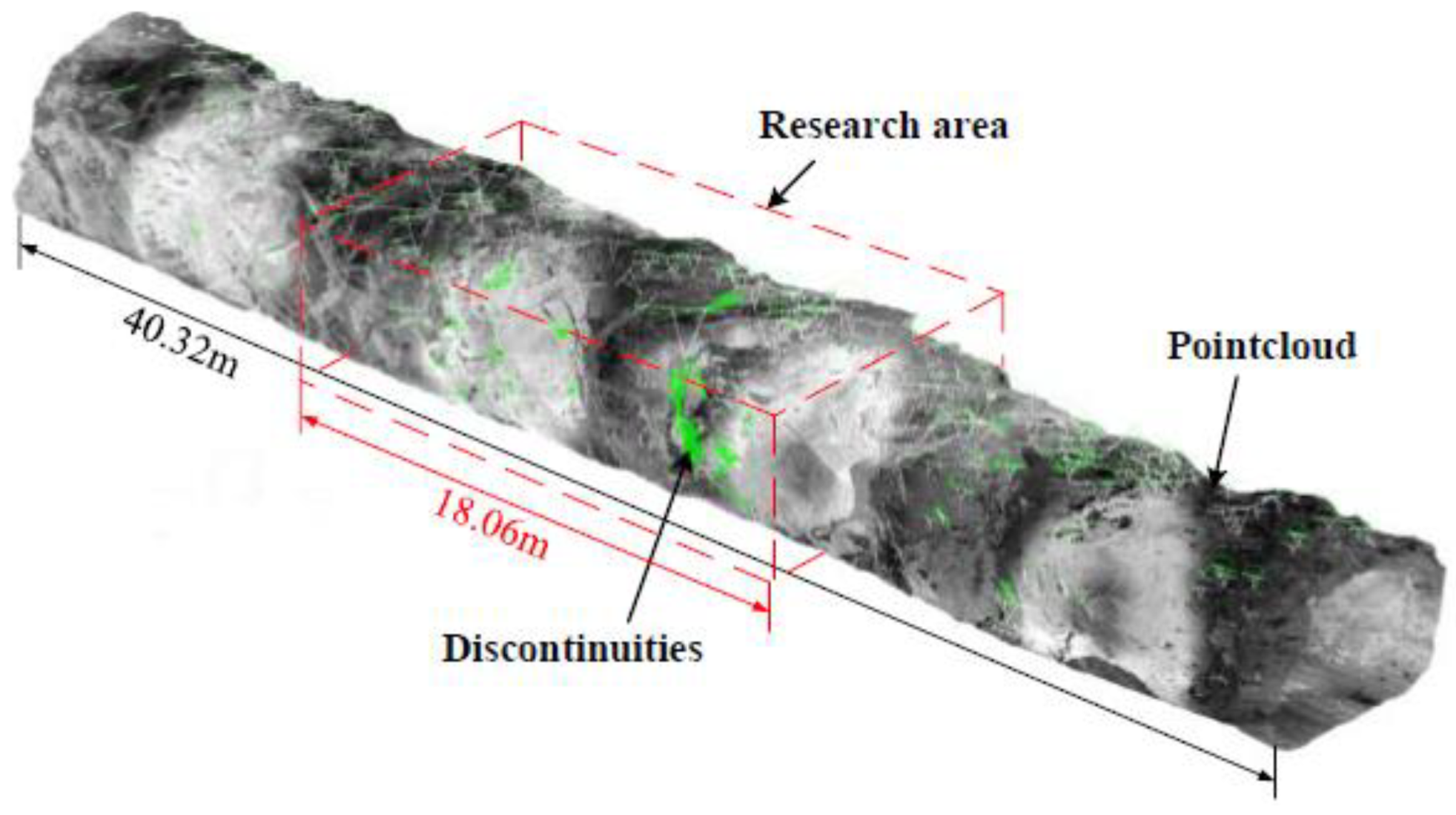

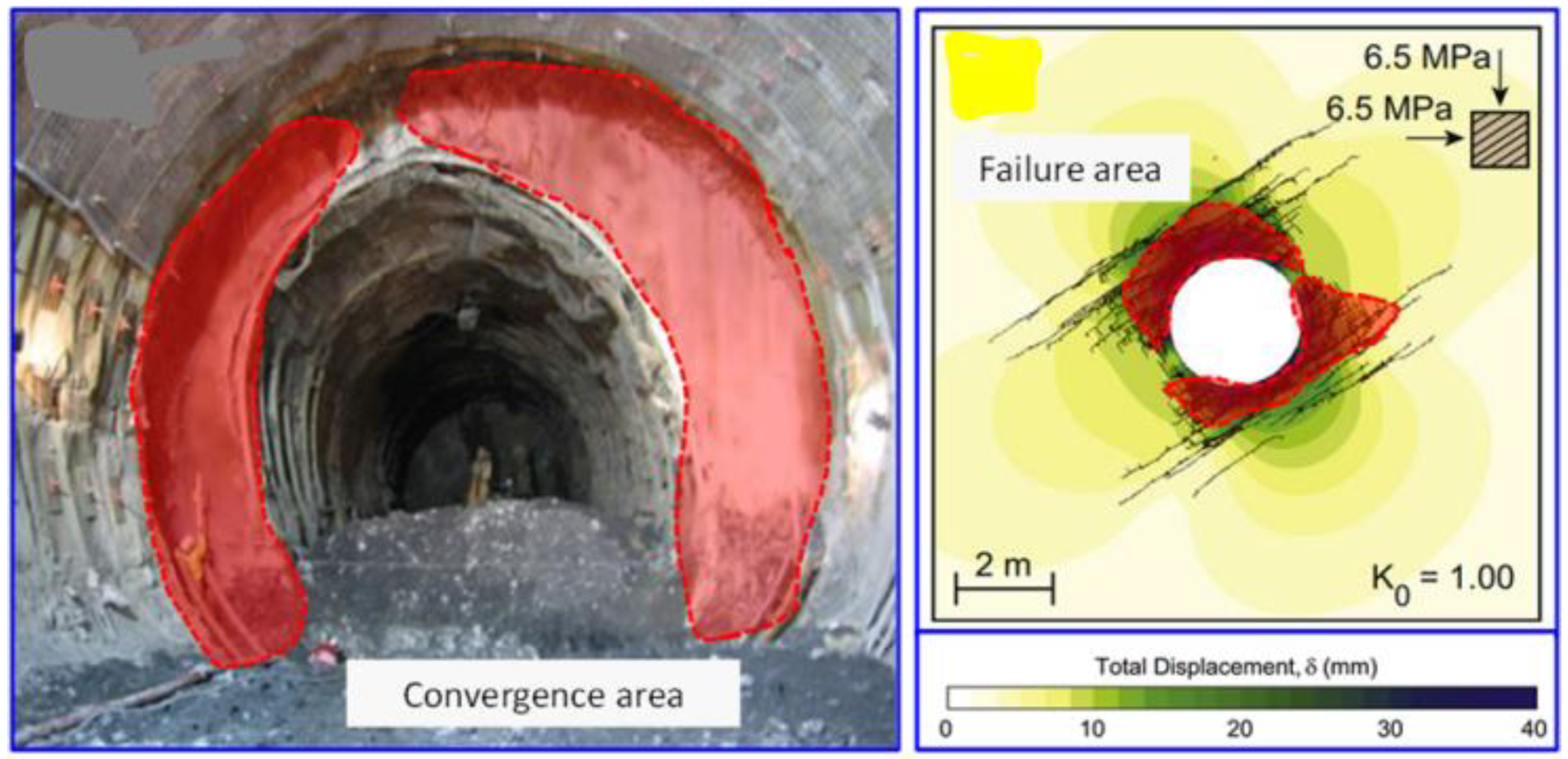
| S/N | Primary Properties | Sources of Data |
|---|---|---|
| 1 | Fracture intensity distribution | Core sample orientation, borehole image interpretation, and mapping |
| 2 | Orientation distribution | Core sample orientation, borehole image log, and mapping |
| 3 | Fracture size distribution | Mapping, ideally at multiple scales |
| 4 | Spatial variation | Interpretation of borehole or mapping data |
| Secondary Properties | ||
| 5 | Fracture stiffness properties | Shear testing techniques from literatures |
| 6 | Fracture shear properties | Core logging, mapping, and shear testing |
| 7 | Aperture distribution | Core logging, mapping, and hydraulic testing |
| 8 | Storativity distribution | Packer testing, well testing |
| 9 | Termination percentage | Mapping |
| 10 | Fracture transmissivity distribution | Packer testing |
| Domain | Data Sources | Spatial Model | Mean P10 | Sizes (m) | Total Number of Models | |
|---|---|---|---|---|---|---|
| Min | Max | |||||
| 1 | 11 boreholes | Enhanced Baecher | 0.007 | 25 | 400 | 35 |
| 2 | 7 boreholes | 0.018 | 75 | 400 | 24 | |
| 4 | Recent underground decline and 4 boreholes | 0.014 | 25 | 400 | 26 | |
| Reference | Summary of Developed DFN Models |
|---|---|
| Adapted from Li [81] | Geological/geotechnical characteristics: bedrock sliding body fracture and rock matrix fracture. Figure: Numerical fractured rock slope model with regularly distributed fractures. Model properties: geometry of length, height, and slope angle as 96 m and 125 m, 50 m, and 95 m and 30° and 40°, for single and multi-fractures containing slopes, respectively. Sliding volume as 447.84 m3 per unit width and the interface or fracture length as 69.282 m for a slope containing one single fracture. Field of deployment: stability of the fractured rock slope. Remarks: The developed DFN model is constrained by the employment of simplified and assumed material parameters and constitutive relations which may affect the accuracy of the model. The unavailability of groundwater flow within the slope may also limit the accuracy of the model. |
| Adapted from Le and Oh. [82] | Geological/geotechnical characteristics: Average sedimentary thickness of 540 m which mainly consists of sandstone, siltstone, gritstone, and coal seams. Two main mine-scale fault sets whose strikes are in parallel and meridian directions. The parallel-oriented strike faults plunge to the north or north–northwest, and their dip angle ranges from 55 to 75 degrees. The mine contains many small-scale faults whose strike directions are like those of the main faults. The panel has an average cover depth of 200 m, extraction thickness of 7.98 m, and seam dip angle of less than 10 degrees. The immediate roof of the coal seam is mainly siltstone with an average thickness of 8.48 m. The main roof is mainly sandstone with a thickness of 16.72 m.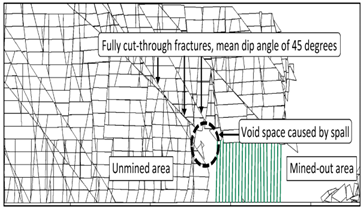 Figure: The impact of a 45-degree fracture dip angle on the stability of the longwall face. Model properties: The model used plane-strain condition because the face advance in panel length was much greater than that in panel width. The model dimensions in vertical direction were 113 m, 250 m in strike direction, and 1 m in the out-of-plane direction. DFN domain of length 50 m and thickness of 8 m. The siltstone floor coal seam, siltstone immediate roof, sandstone main roof, and siltstone overburden measured 40, 8, 8.5, 16.5, and 40 metres in thickness, respectively, from bottom to top. Bedding planes spacing of 0.5 m, mean dip angle of 115, and 90 degrees for the first and second fracture sets, respectively. Field of deployment: coal seam longwall face stability. Remarks: Due to limited field mapping and laboratory testing, a few assumptions were made to determine the inputs for the model; nevertheless, their impact on the model’s outputs is minimized by a comprehensive calibration and validation procedure versus field measurement. |
| Adapted from Singh [83] | Geological/geotechnical characteristics: Upper Tal Formation dominantly consisting of orthoquartzite and arkosic sandstone and partial partings of mudstone. Cretaceous anikot shelly limestone. The rock group belongs to a regional-scale syncline known as Garhwal Syncline. 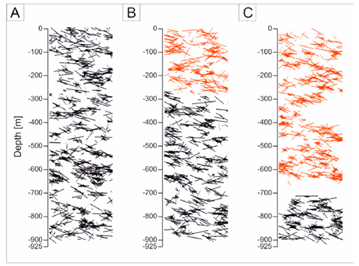 Figure: Developed DFN for site 2 having three joint sets coloured yellow, pink, and dark green (not to scale). Model properties: Three persistent joint sets were considered per each of the studied sites in the DFN model. The length of the joints range between 0.9 m ± 1.23 and 4.75 m ± 0.87 for the three sites. Both log-normal and power-law were the length distributions adopted. The average Fisher dip/dip direction ranged between 35/30 and 80/80, and the average fracture intensities (P32) were between 0.451 and 4.5. Field of deployment: rock slope stability along national highway. Remarks: Due to the broad variability of rock mass properties, engineering professionals are encouraged to study each rock mass independently in the proximity of structurally damaged zones. |
| Tóth [84] | Geological/geotechnical characteristics: The host rock is the Boda Claystone Formation (BCF). The formation consists of well-compacted reddish-brown claystone, siltstone, and albitolite (authigenic albite >50%) with dolomite and sandstone intercalations. The formation maximum thickness is 1000 m and with a distribution area of 150 square kilometres. The average dip direction of the bedding in the well is SE–SSE, and the dip is 40° based on acoustic borehole televiewer (BHTV) observations. Four classes of veins including branched veins, straight veins, en echelon vein arrays, and breccia-like veins characterized the deepest well of the formation (BAF-2). In the BAF–2 well, the average dip values of the vein types are 42° (branched veins), 70° (straight veins), and 22° (en echelon vein arrays).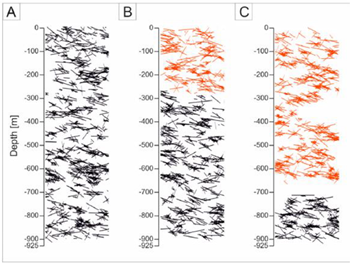 Figure: Vertical sections of simulated fracture network geometry patterns (A–C) of the BAF–2 well based on 20 independent runs. Model properties: the DFN model domain was 150 × 150 × 925 m. Field of deployment: High-level radioactive waste repository deep well. The average fracture density (P10) was 9–10 . The average fractal dimension (D) was 1.37 ± 0.05 while the single length exponent (E) value was −0.90 and the F parameter value was 10.00. The borehole planes dip in SSE direction with an average orientation of 162° N—60° E. Remarks: the study is basic and could be improved upon to provide detailed hydrodynamic modelling of the well and its environment. |
| Adapted from Gao [85] | Geological/geotechnical characteristics: The lithology of the formation is made up of biotite granodiorite in the basement and gravel sand and breccia in the upper layers. Gravel sand and breccia are mixed, and their thickness typically ranges between 0 and 16.8 m from northeast to southwest. The formation is characterized by several structural and weathering fractures that are relatively straight, and the apertures are generally ~0.1–2 mm. Figure: (a) A finite volume DFN model; (b) P10 obtained by virtual drilling at an interval of 2 m. Model properties: The rock mass is characterized by at least three fracture sets striking orthogonally towards northeast and northwest directions. The DFN model domain was a cuboid model (length = width = 10 m, height = 5 m). The P32 values range between 0.1 (m2/m3) and 4 (m2/m3). The fracture size was dmin = 2 m, dmax = 25 m, b = 1.9343. Field of deployment: spent fuel reprocessing (SFR) site fracture characterization. Remarks: By effectively capturing the variability in fracture spatial intensity, the framework employed in this study addresses the primary drawback of the conventional DFN models. The DFN model can, however, be improved upon and optimized inside this framework in the future by including more important information. |
| Adapted from Zhu [86] | Geological/geotechnical characteristics: Shale reservoirs with natural fractures and hydro-fractures.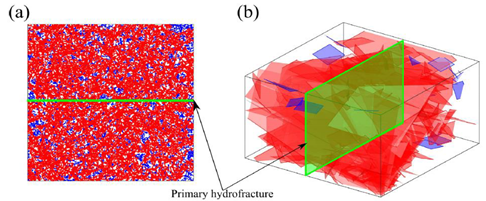 Figure: DFN model: (a) 2D fracture network; (b) 3D fracture network. Model properties: Stochastic DFN domain with 2D and 3D fractures represented by a line segment (100 m × 100 m) and square plate (50 m × 50 m × 50 m), respectively. The minimum and maximum fracture length used in the power-law distribution is 1 m and 100,000 m. The fractal dimension (FD) varies between 1.1 and 2.0 and between 2.1 and 3.0 for 2D and 3D fracture networks, respectively. Fracture intensity (FI) for 2D and 3D fracture networks range between 0.8 and 2.6. Injected fluid pressure of hydraulic fracturing (Pf) = 1; maximum horizontal stress (Shmax) = 1.3 Pf; minimum horizontal stress (Shmin) = 0.8 Pf; vertical stress (Sv) = 1.1 Pf; reservoirs pressure (Pp) = 0.5 Pf; segment length (Lse) from between 1 m and 0.2 m. Fracture roughness (JRC) and strength (JCS) and fracture orientation (k) vary between 0 and 20, 0.5 Pf and 18.5 Pf, and 0 and 20, respectively. Field of deployment: sensitivity analysis of the impacts of the fracture network on the formation and development of stimulated reservoirs’ volume. Remarks: It is crucial to precisely measure the fracture sealing degree, fracture intensity, and fracture orientations of the subsurface fracture networks to accurately estimate SRV or have a good production prediction. |
| Adapted fromWu [87] | Geological/geotechnical characteristics: The rock slope rock mass environment is complex and characterized by three major fracture groups with orientations of 25.98/235.15, 28.16/351.34, and 85.80/94.73, respectively. The trace length and spacing of the three fracture groups are 3.42/1.35, 3.12/1.70, and 2.96/0.69, respectively. Figure: The three-dimensional equivalent DFN model’s construction process (a) rock model, (b) DFN model, and (c) equivalent DFN model. Model properties: The DFN domain was 15 m × 15 m ×15 m and the model of fracture rock masses was 8 m × 8 m × 8 m. Model edges of between 2 m and 15 m were established to investigate scale effects and anisotropy of the fractured rock masses. Displacement load of times the model edge per step was applied to the model. The heterogeneity, UCS, elastic modulus, friction angle, and Poisson’s ratio of the rock and fracture for the numerical model were, 5 108.9, 37.6, 56, and 0.24; and 2, 5.45, 1.88, 30, and 0.39, respectively. A water head (initial head H1 = 0) with an increase (ΔH) of 0.3 mm/step was applied to the surface in the positive direction of the Z-axis, and the water head (H2 = 0) in the corresponding negative direction was zero in the model. Field of deployment: hydropower station project. Remarks: Nevertheless, the suggested paradigm has some drawbacks. The dynamics, impacts of stress changes, fracture interactions, significant displacement, and rotation issues of natural fracture systems cannot be fully considered. |
| Adapted from Lei [1] | Geological/geotechnical characteristics: The rock mass is a crystalline rock with incompressible grains and networks of fractures of varying lengths and intensities. The intact rock is characterized by density (Ρ), young modulus (E), Poisson’s ratio (v), internal friction angle (φint), tensile strength (ft), cohesion (c), mode I energy release rate (GI), mode II energy release rate (GII), and matrix permeability (Km) values of 2680 kg.m−3, 60.0 GPa, 0.25, 35.0°, 15.0 MPa, 55.0 MPa, 74.3 J.m−2, 88.4 J.m−2, and 1 × 10−15 m2, respectively. The fracture is characterized by residual friction angle (φr), laboratory sample length (L0), joint roughness coefficient (JRC), and joint compressive strength (JCS) values of 31.0°, 0.2 m, 150.0 MPa, and10.0, respectively. Figure: Generated DFN (a) length exponent (a) = 1.5 and fracture intensity (P21) = 1.0 m−1; (b) isotropic in situ stress condition before excavation; (c) isotropic in situ stress condition after excavation; (d) anisotropic in situ stress condition before excavation; (e) isotropic in situ stress condition after excavation. Model properties: The DFN domain was 20 m × 20 m. The fracture length bounds were defined as lmin = L/100 = 0.2 m and lmax = 100L = 2000 m. Length exponent (a) of 1.5, 2.5, and 3.5 and fracture intensity (P21) values of 1.0, 2.0, and 3.0 m−1 were adopted. Overburden stress (S′v) = 8.0 MPa, S′H/ S′v =1.0 and 2.0, i.e., S′H = 8.0 and 16.0 MPa, respectively. Average element size (h) = 5.0 cm, diameter of tunnel (d) = 2 m, penalty term (p) = 600 GPa, and damping coefficient (η) = 6.34 × 105 kg/m·s. Field of deployment: tunnel excavation in fractured rock masses. Remarks: The presence and distribution of natural cracks in the subsurface were found to have a substantial impact on the parameters of the excavation damaged zone (EDZ). |
Disclaimer/Publisher’s Note: The statements, opinions and data contained in all publications are solely those of the individual author(s) and contributor(s) and not of MDPI and/or the editor(s). MDPI and/or the editor(s) disclaim responsibility for any injury to people or property resulting from any ideas, methods, instructions or products referred to in the content. |
© 2023 by the authors. Licensee MDPI, Basel, Switzerland. This article is an open access article distributed under the terms and conditions of the Creative Commons Attribution (CC BY) license (https://creativecommons.org/licenses/by/4.0/).
Share and Cite
Kolapo, P.; Ogunsola, N.O.; Munemo, P.; Alewi, D.; Komolafe, K.; Giwa-Bioku, A. DFN: An Emerging Tool for Stochastic Modelling and Geomechanical Design. Eng 2023, 4, 174-205. https://doi.org/10.3390/eng4010011
Kolapo P, Ogunsola NO, Munemo P, Alewi D, Komolafe K, Giwa-Bioku A. DFN: An Emerging Tool for Stochastic Modelling and Geomechanical Design. Eng. 2023; 4(1):174-205. https://doi.org/10.3390/eng4010011
Chicago/Turabian StyleKolapo, Peter, Nafiu Olanrewaju Ogunsola, Prosper Munemo, Damilola Alewi, Kayode Komolafe, and Ahmid Giwa-Bioku. 2023. "DFN: An Emerging Tool for Stochastic Modelling and Geomechanical Design" Eng 4, no. 1: 174-205. https://doi.org/10.3390/eng4010011
APA StyleKolapo, P., Ogunsola, N. O., Munemo, P., Alewi, D., Komolafe, K., & Giwa-Bioku, A. (2023). DFN: An Emerging Tool for Stochastic Modelling and Geomechanical Design. Eng, 4(1), 174-205. https://doi.org/10.3390/eng4010011







